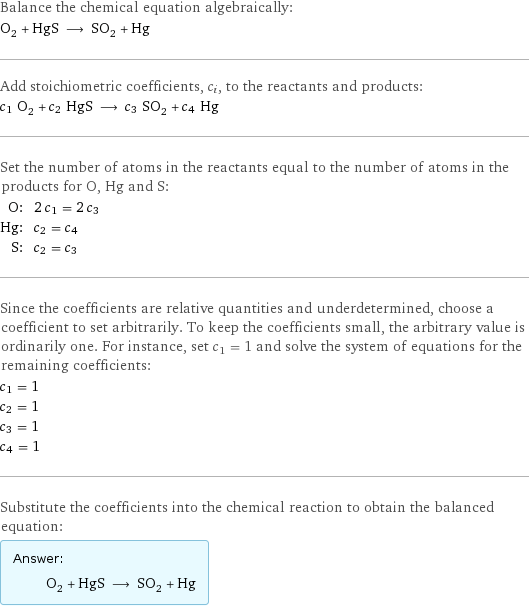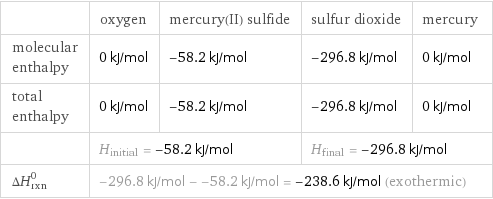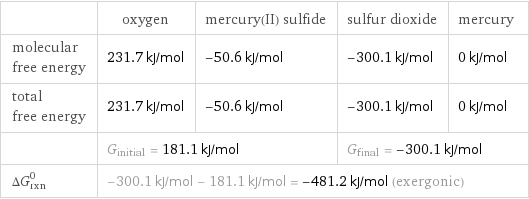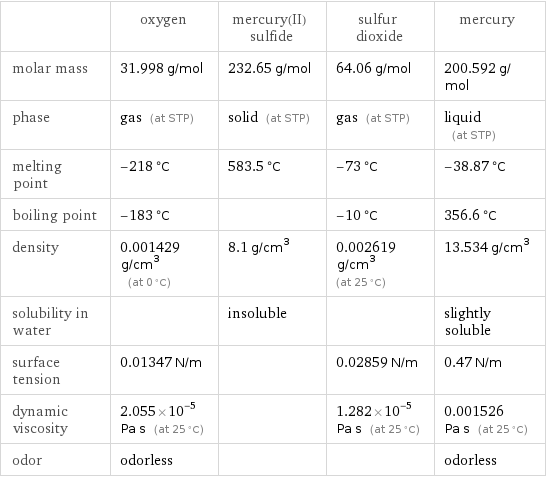Input interpretation

O_2 (oxygen) + HgS (mercury(II) sulfide) ⟶ SO_2 (sulfur dioxide) + Hg (mercury)
Balanced equation

Balance the chemical equation algebraically: O_2 + HgS ⟶ SO_2 + Hg Add stoichiometric coefficients, c_i, to the reactants and products: c_1 O_2 + c_2 HgS ⟶ c_3 SO_2 + c_4 Hg Set the number of atoms in the reactants equal to the number of atoms in the products for O, Hg and S: O: | 2 c_1 = 2 c_3 Hg: | c_2 = c_4 S: | c_2 = c_3 Since the coefficients are relative quantities and underdetermined, choose a coefficient to set arbitrarily. To keep the coefficients small, the arbitrary value is ordinarily one. For instance, set c_1 = 1 and solve the system of equations for the remaining coefficients: c_1 = 1 c_2 = 1 c_3 = 1 c_4 = 1 Substitute the coefficients into the chemical reaction to obtain the balanced equation: Answer: | | O_2 + HgS ⟶ SO_2 + Hg
Structures

+ ⟶ +
Names

oxygen + mercury(II) sulfide ⟶ sulfur dioxide + mercury
Reaction thermodynamics
Enthalpy

| oxygen | mercury(II) sulfide | sulfur dioxide | mercury molecular enthalpy | 0 kJ/mol | -58.2 kJ/mol | -296.8 kJ/mol | 0 kJ/mol total enthalpy | 0 kJ/mol | -58.2 kJ/mol | -296.8 kJ/mol | 0 kJ/mol | H_initial = -58.2 kJ/mol | | H_final = -296.8 kJ/mol | ΔH_rxn^0 | -296.8 kJ/mol - -58.2 kJ/mol = -238.6 kJ/mol (exothermic) | | |
Gibbs free energy

| oxygen | mercury(II) sulfide | sulfur dioxide | mercury molecular free energy | 231.7 kJ/mol | -50.6 kJ/mol | -300.1 kJ/mol | 0 kJ/mol total free energy | 231.7 kJ/mol | -50.6 kJ/mol | -300.1 kJ/mol | 0 kJ/mol | G_initial = 181.1 kJ/mol | | G_final = -300.1 kJ/mol | ΔG_rxn^0 | -300.1 kJ/mol - 181.1 kJ/mol = -481.2 kJ/mol (exergonic) | | |
Equilibrium constant
![Construct the equilibrium constant, K, expression for: O_2 + HgS ⟶ SO_2 + Hg Plan: • Balance the chemical equation. • Determine the stoichiometric numbers. • Assemble the activity expression for each chemical species. • Use the activity expressions to build the equilibrium constant expression. Write the balanced chemical equation: O_2 + HgS ⟶ SO_2 + Hg Assign stoichiometric numbers, ν_i, using the stoichiometric coefficients, c_i, from the balanced chemical equation in the following manner: ν_i = -c_i for reactants and ν_i = c_i for products: chemical species | c_i | ν_i O_2 | 1 | -1 HgS | 1 | -1 SO_2 | 1 | 1 Hg | 1 | 1 Assemble the activity expressions accounting for the state of matter and ν_i: chemical species | c_i | ν_i | activity expression O_2 | 1 | -1 | ([O2])^(-1) HgS | 1 | -1 | ([HgS])^(-1) SO_2 | 1 | 1 | [SO2] Hg | 1 | 1 | [Hg] The equilibrium constant symbol in the concentration basis is: K_c Mulitply the activity expressions to arrive at the K_c expression: Answer: | | K_c = ([O2])^(-1) ([HgS])^(-1) [SO2] [Hg] = ([SO2] [Hg])/([O2] [HgS])](../image_source/5acbbab91b8750d3095ca7b615e516ca.png)
Construct the equilibrium constant, K, expression for: O_2 + HgS ⟶ SO_2 + Hg Plan: • Balance the chemical equation. • Determine the stoichiometric numbers. • Assemble the activity expression for each chemical species. • Use the activity expressions to build the equilibrium constant expression. Write the balanced chemical equation: O_2 + HgS ⟶ SO_2 + Hg Assign stoichiometric numbers, ν_i, using the stoichiometric coefficients, c_i, from the balanced chemical equation in the following manner: ν_i = -c_i for reactants and ν_i = c_i for products: chemical species | c_i | ν_i O_2 | 1 | -1 HgS | 1 | -1 SO_2 | 1 | 1 Hg | 1 | 1 Assemble the activity expressions accounting for the state of matter and ν_i: chemical species | c_i | ν_i | activity expression O_2 | 1 | -1 | ([O2])^(-1) HgS | 1 | -1 | ([HgS])^(-1) SO_2 | 1 | 1 | [SO2] Hg | 1 | 1 | [Hg] The equilibrium constant symbol in the concentration basis is: K_c Mulitply the activity expressions to arrive at the K_c expression: Answer: | | K_c = ([O2])^(-1) ([HgS])^(-1) [SO2] [Hg] = ([SO2] [Hg])/([O2] [HgS])
Rate of reaction
![Construct the rate of reaction expression for: O_2 + HgS ⟶ SO_2 + Hg Plan: • Balance the chemical equation. • Determine the stoichiometric numbers. • Assemble the rate term for each chemical species. • Write the rate of reaction expression. Write the balanced chemical equation: O_2 + HgS ⟶ SO_2 + Hg Assign stoichiometric numbers, ν_i, using the stoichiometric coefficients, c_i, from the balanced chemical equation in the following manner: ν_i = -c_i for reactants and ν_i = c_i for products: chemical species | c_i | ν_i O_2 | 1 | -1 HgS | 1 | -1 SO_2 | 1 | 1 Hg | 1 | 1 The rate term for each chemical species, B_i, is 1/ν_i(Δ[B_i])/(Δt) where [B_i] is the amount concentration and t is time: chemical species | c_i | ν_i | rate term O_2 | 1 | -1 | -(Δ[O2])/(Δt) HgS | 1 | -1 | -(Δ[HgS])/(Δt) SO_2 | 1 | 1 | (Δ[SO2])/(Δt) Hg | 1 | 1 | (Δ[Hg])/(Δt) (for infinitesimal rate of change, replace Δ with d) Set the rate terms equal to each other to arrive at the rate expression: Answer: | | rate = -(Δ[O2])/(Δt) = -(Δ[HgS])/(Δt) = (Δ[SO2])/(Δt) = (Δ[Hg])/(Δt) (assuming constant volume and no accumulation of intermediates or side products)](../image_source/1e0f27ea5e4c06ae342e5b6a57461c4b.png)
Construct the rate of reaction expression for: O_2 + HgS ⟶ SO_2 + Hg Plan: • Balance the chemical equation. • Determine the stoichiometric numbers. • Assemble the rate term for each chemical species. • Write the rate of reaction expression. Write the balanced chemical equation: O_2 + HgS ⟶ SO_2 + Hg Assign stoichiometric numbers, ν_i, using the stoichiometric coefficients, c_i, from the balanced chemical equation in the following manner: ν_i = -c_i for reactants and ν_i = c_i for products: chemical species | c_i | ν_i O_2 | 1 | -1 HgS | 1 | -1 SO_2 | 1 | 1 Hg | 1 | 1 The rate term for each chemical species, B_i, is 1/ν_i(Δ[B_i])/(Δt) where [B_i] is the amount concentration and t is time: chemical species | c_i | ν_i | rate term O_2 | 1 | -1 | -(Δ[O2])/(Δt) HgS | 1 | -1 | -(Δ[HgS])/(Δt) SO_2 | 1 | 1 | (Δ[SO2])/(Δt) Hg | 1 | 1 | (Δ[Hg])/(Δt) (for infinitesimal rate of change, replace Δ with d) Set the rate terms equal to each other to arrive at the rate expression: Answer: | | rate = -(Δ[O2])/(Δt) = -(Δ[HgS])/(Δt) = (Δ[SO2])/(Δt) = (Δ[Hg])/(Δt) (assuming constant volume and no accumulation of intermediates or side products)
Chemical names and formulas

| oxygen | mercury(II) sulfide | sulfur dioxide | mercury formula | O_2 | HgS | SO_2 | Hg Hill formula | O_2 | HgS | O_2S | Hg name | oxygen | mercury(II) sulfide | sulfur dioxide | mercury IUPAC name | molecular oxygen | thioxomercury | sulfur dioxide | mercury
Substance properties

| oxygen | mercury(II) sulfide | sulfur dioxide | mercury molar mass | 31.998 g/mol | 232.65 g/mol | 64.06 g/mol | 200.592 g/mol phase | gas (at STP) | solid (at STP) | gas (at STP) | liquid (at STP) melting point | -218 °C | 583.5 °C | -73 °C | -38.87 °C boiling point | -183 °C | | -10 °C | 356.6 °C density | 0.001429 g/cm^3 (at 0 °C) | 8.1 g/cm^3 | 0.002619 g/cm^3 (at 25 °C) | 13.534 g/cm^3 solubility in water | | insoluble | | slightly soluble surface tension | 0.01347 N/m | | 0.02859 N/m | 0.47 N/m dynamic viscosity | 2.055×10^-5 Pa s (at 25 °C) | | 1.282×10^-5 Pa s (at 25 °C) | 0.001526 Pa s (at 25 °C) odor | odorless | | | odorless
Units
